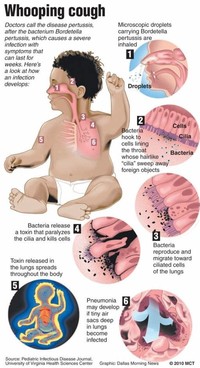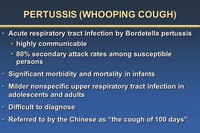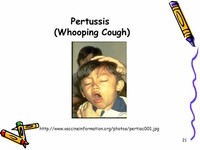Facts about Pertussis

Sato's acellular pertussis vaccine was used in Japan since the autumn of 1981 (Sato et al.

Despite an effective vaccine and generally high coverage with this vaccine, pertussis is one of the leading causes of vaccine-preventable deaths worldwide.

Pertussis was recognizably described as early as 1578 by Guillaume de Baillou (1538-1616), but earlier reports date back at least to the twelfth century (Versteegh et al.

Later versions of the acellular pertussis vaccine used in other countries consisted of additional defined components of B. pertussis and were often part of the DTaP combination vaccine.

The most severe symptoms of whooping cough are caused by B. pertussis attaching itself to those respiratory tract cells with cilia (Carson-Dewitt 2006).

A similar disease to whooping cough, but milder, is caused B. parapertussis (Finger and von Koenig 1996).

Most deaths occur in young infants who are either unvaccinated or incompletely vaccinated; three doses of the vaccine are necessary for complete protection against pertussis.

Pertussis is spread by contact with airborne discharges from the mucous membranes of infected people, who are most contagious during the catarrhal stage.

Infection with pertussis induces immunity, but not lasting protective immunity, and a second attack is possible (Miller et al.

When there is residual immunity from previous infection or immunization, symptoms may be milder, such as a prolonged cough without the other classic symptoms of pertussis.

In 1942, the American scientist Pearl Kendrick combined the whole-cell pertussis vaccine with diphtheria and tetanus toxoids to generate the first DTP combination vaccine.

The complete B. pertussis genome of 4,086,186 base pairs was sequenced in 2002.

Most adults and adolescents who become infected with Bordetella pertussis have been vaccinated or infected years previously.

After the incubation period, pertussis in infants and young children is characterized initially by mild respiratory infection symptoms such as cough, sneezing, and runny nose (catarrhal stage).

Pertussis vaccines are highly effective, strongly recommended, and save many infant lives every year.

In 1925, the Danish physician Thorvald Madsen was the first to test a whole-cell pertussis vaccine on a wide scale (Baker and Katz 2004).

B. pertussis was isolated in pure culture in 1906 by Jules Bordet and Octave Gengou, who also developed the first serology and vaccine.

There does not appear to be a zoonotic reservoir for B. pertussis—humans are its only host.

By the late 1970s, publicity about adverse reactions and deaths following pertussis vaccination caused the immunization rate to fall in several countries, including Great Britain, Sweden, and Japan.

The acetic acid concentration in vinegar typically ranges from 4 to 8 percent by volume for table vinegar (USFDA 1995), though higher concentrations are found in vinegars used for pickling (up to 18 percent).

Much of the controversy surrounding the DTP vaccine in the 1970s and 1980s related to the question of whether the whole-cell pertussis component caused permanent brain injury in rare cases.

Adults and adolescent family members are the major source of transmission of the bacteria to unimmunized or partially immunized infants, who are at greatest risk of severe complications from pertussis.

The most serious side-effects of traditional "whole-cell" pertussis immunizations were neurological and included seizures and hypotonic episodes.

Worldwide, there are 30–50 million pertussis cases and about 300,000 deaths per year.

Whooping cough or pertussis is caused by Bordetella pertussis, a Gram-negative, aerobic coccobacillus.

Three macrolides, erythromycin, azithromycin, and clarithromycin, are used in the United States for treatment of pertussis; trimethoprim-sulfamethoxazole is generally used when a macrolide is ineffective or is contraindicated.

Pertussis was recognizably described as early as 1578 by Guillaume de Baillou (1538-1616), but earlier reports date back at least to the twelfth century (Versteegh et al.
